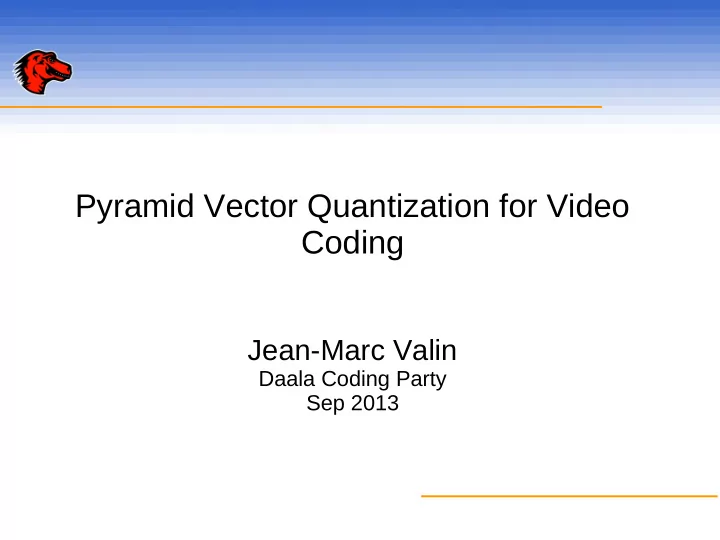

Pyramid Vector Quantization for Video Coding Jean-Marc Valin Daala Coding Party Sep 2013
Motivations ● Pyramid vector quantization is a key technique used in Opus (both SILK and CELT parts) ● Investigate PVQ for a video codec (Daala) ● Potential advantages – Preserves energy (details) even when details are imperfect (instead of blurring) – Implicit activity masking – Better representation of coefficients
Gain-Shape Quantization ● Represent a vector as magnitude multiplied by unit-norm vector (radius + point on sphere) – Amount of texture vs exact details ● Code magnitude separately – Adjust resolution of the sphere based on the magnitude
Pyramid Vector Quantizer (PVQ) ● Place K unit pulses in N dimensions – Up to N = 1024 dimensions ● Normalize to unit norm (L 2 )
Codebook for N =3 and different K
Distortion, N and K Fewer pulses needed D = N 2 /(24K 2 )
PVQ vs Scalar Quantization -6 dB/bit
Prediction ● Unlike CELT, we want to predict the vectors ● PVQ on the residual loses energy preservation ● Apply prediction in the normalized vector – Use Householder reflection to align prediction with one axis – Encode magnitude of the residual as an angle
2-D Projection ● Input Input
2-D Projection ● Input+prediction Prediction Input
2-D Projection ● Input+prediction ● Compute reflection plane Prediction Input
2-D Projection ● Input+prediction ● Compute reflection plane ● Apply reflection Prediction Input
2-D Projection ● Input+prediction ● Compute reflection plane ● Apply reflection ● Compute/code angle Prediction θ Input
2-D Projection ● Input+prediction ● Compute reflection plane ● Apply reflection ● Compute/code angle ● Code other Prediction dimensions θ Input
Activity Masking ● Artefacts are easier to detect on flat areas they on textured areas – Code unit-norm vector with a resolution that depends on the gain (texture) ● Code companded gain g c = g – Implicit activity masking built into the bitstream
Open Questions ● How to split into bands ● Avoid wasting bits on still video ● Quantization matrix ● Take advantage of correlation/prediction in gain and angle ● Rate-Distortion Optimization – Fast RDO PVQ search?
Recommend
More recommend